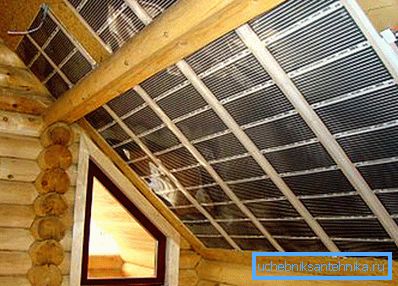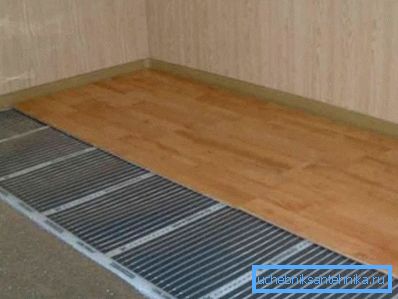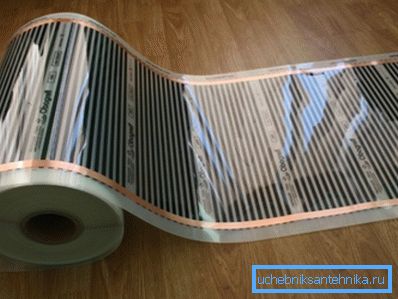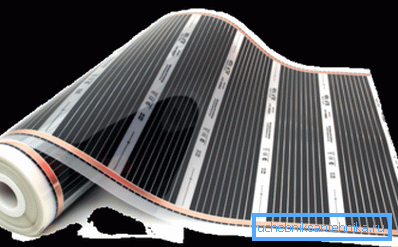Infrared film for heating - the device and features
Room heating technologies are constantly evolving, with the result that new heating devices are emerging. An example of this is the infrared film, which has been used in heating systems recently, but has already managed to acquire a certain popularity.
In this article, we take a closer look at the device of such a film and the features of heating with it.

Film device
So, this heater is a flexible, but at the same time rather dense film made of dielectric plastic. This material is sprayed with thin wide copper tires through which electric current flows. Between these tires are thin tracks of conductive material with high resistance.
As a result, when the device is connected to electricity, a potential difference arises on the tires, which in turn leads to heating of the conductors.

The cross section of the tracks and the resistivity are chosen in such a way that the heating would be noticeable, but at the same time would not cause the dielectric film to melt. In addition, the heating infrared film is necessarily equipped with a thermostat, which serves as an additional protection that does not allow the device to heat up above a predetermined temperature.
Most often, such a device is used for floor heating systems. However, due to its flexibility, it can be used for walls or even the ceiling. In addition, the film is often used for heating greenhouses, as a dryer for food, etc.
Note! If the part of the heated floor, located far from the thermostat for heating, will be covered with a carpet or there will be furniture on it, the film may still overheat. Therefore, product manufacturers recommend to install a warm floor only in open areas.
The specific power of the film, which is used for floor heating, is 150 - 220 watts per square meter.

Features heating foil
As it is not difficult to guess from the name, the device generates infrared radiation, which the human body perceives as thermal. The maximum heating temperature reaches 50 degrees Celsius, however, it can be less depending on the type of product.

When using a film in a heated floor system, the initial radiation heats up the finishing material, for example, tile, and that in turn radiates heat into space. The main feature of this heating is the minimum thickness. Therefore, for the arrangement of warm floor does not need to perform a coupler.
The product can be laid on the surface under the finishing material. The only thing is that the surface should be smooth, otherwise the heating device may be damaged.
Merits
Among the advantages of using this heating device are the following points:
- Film floor provides an even distribution of heat in the room, making it more economical than the traditional system of radiators with an electric boiler for heating.
- Laying the device with your own hands does not cause any problems, however, it is better to entrust the connection to specialists.
- As mentioned above, a concrete screed is not required for installation of the system, in contrast to the installation of an electric or water heated floor.
- Ability to lay under any floor covering.
disadvantages
Of course, on a par with the merits, this device has some drawbacks, among which are:
- The warranty on the system does not exceed 10 years, while the thermal sensor and thermostat may fail after 7 years.
- Manufacturers of the product promise cost-effectiveness, however, for this the heating temperature of the device should not exceed 21 degrees, which completely eliminates the heating of the room in such conditions.
- When using carpet or linoleum on top of the film it is necessary to lay a material like fiberboard.
- Relatively high price of the product.
- Despite the insulation of the contacts, flooding the floor can lead to a short circuit.
- Heating is not enough to use the device as the main source of heating in our climate.
For these reasons, it cannot be said that the use of this appliance is the best option for space heating.

Types of films
Infrared film heaters, presented by different manufacturers, can differ in many parameters.
However, all of them can be divided into two types:
- Low temperature - able to heat up to a temperature not exceeding 27-30 degrees.
- High temperature - heating temperature reaches 50 degrees.
From these parameters, of course, depends on the scope of the product. For example, a film designed to heat more than 27 degrees is not suitable for use under a laminated coating, as it is deformed under the influence of high temperature. But under the ceramic tiles such a device would be an excellent option.
Tip! A narrow film, about 13 cm thick, can be used for plinth heating.
In addition, the differences between these products are in the following parameters:
- Power;
- Sizes;
- Type of application of the radiating material, etc.

All these parameters are selected depending on the needs of the heating system. Separately, it should be said about the differences of the radiating material. To date, there are two types of films:
| Graphite | Until recently, these films were on sale, so they can be called traditional. |
| Carbon fiber | These products are new to the market. Differ in the thickness of the thread, the diameter of which does not exceed 0.005 mm. Despite the fact that the threads are so thin, it does not affect the strength of the product, since it is almost impossible to tear them. |
It should be noted that the cost of carbon films is significantly higher than graphite films, which is associated with the peculiarities of their production. However, they have a much longer service life and more stable technical indicators, therefore they are a profitable acquisition.

Device selection
The variety of the film, which is available on the market of building materials, can puzzle everyone. Therefore, in order to facilitate the selection, it is first necessary to proceed from the initial conditions. As mentioned above, first of all, you should determine the maximum temperature of the floors, which depends on the type of finishing coating.
For example, an infrared heating film Heat Plus, Power Plus, Caleo or RexVa XiCa would be an excellent option for a laminated coating. The maximum temperature of these models does not exceed 27 degrees.
Note! Film floor is better to use in rooms with low ceilings, as in high rooms its use is unprofitable.
If carpet or ceramic tile is used as a cover, then infrared heating film Heat Life, Eco, Excel, etc. will be suitable.
Here, in fact, the entire instruction for choosing a film.
Conclusion
The use of infrared film for space heating has many advantages, although it cannot be said that this is the ideal heating solution. Therefore, it is usually used as a supplement to the traditional heating system.
From the video in this article, you can pick up some additional information on this topic.